 Diversity, Violence Prevention & Creativity Workshop Series
Diversity, Violence Prevention & Creativity Workshop Series
These gentle, interactive, art-based workshops are appropriate and adapted for all ages from school-age to senior citizens.
Each workshop involves “self-discovery” and discussion based on activities participants engage in. Topics addressed include: diversity issues (age, gender, race, socio-economic status, language, disability, etc.), communication, bullying, group dynamics, problem-solving, conflict resolution & more.
For groups, agencies, social workers, therapists, facilitators, health care professionals, schools, universities, government workers, and businesses.
FACES IN THE CROWD
Workshop Objectives & Activities
1. Immigrants & Visitors –Objectives:
- To introduce the Faces in the Crowd Workshop series.

- To introduce the concept of “the story” and how stereotypes are formed.
- To help participants begin to look introspectively at their attitudes and beliefs about other people.
- To begin to assist participants in their work place role as a service provider to the diverse consumer population they serve.
Activities: Participants take on role of different person, role-play conversation with partner and create story based on mask identity; learn nature of the “story,” They discuss stereotypes based on race, appearance, media images etc. as well as phenomenon of “invisible persons.”
2. Assumptions – Objectives:
- For participants to examine their own process in making assumptions about other people.
- To understand their own and others’ social comfort levels.
- To apply this deeper understanding to their personal and workplace interactions with others.
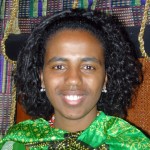 Activities: With mask identity, participants face a “pop-up” crowd and examine their assumptions based on physical appearance. Participants learn the nature of assumptions and how these assumptions are impacted by individual perspectives. Applications to work place experiences are discussed.
Activities: With mask identity, participants face a “pop-up” crowd and examine their assumptions based on physical appearance. Participants learn the nature of assumptions and how these assumptions are impacted by individual perspectives. Applications to work place experiences are discussed.
3. Social Twister – Objectives:
- To help participants discover and examine their own decisio
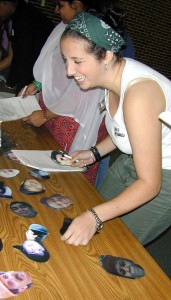 nmaking process regarding other people.
nmaking process regarding other people. - To understand objective and subjective factors which influence their own decision making processes.
- To apply these insights concerning decision making to their personal and workplace experiences.
Activities: Participants make choices and decisions concerning people (using multi-cultural cards) based on appearance and other qualities. Participants learn about how and why decisions about others are
people (using multi-cultural cards) based on appearance and other qualities. Participants learn about how and why decisions about others are
made.
4. Race Course – Objectives:
To enhance participants’ understanding of how certain individuals may be supported or thwarted by cultural expectations to succeed or fail. To enhance participants’ sense of justice and fairness in making decisions about others.
 Activities: Participants make choices and decisions concerning people (using multi-cultural cards) based on appearance and other qualities. Participants learn about how and why decisions about others are made and discuss validity of decisions and decision making process.
Activities: Participants make choices and decisions concerning people (using multi-cultural cards) based on appearance and other qualities. Participants learn about how and why decisions about others are made and discuss validity of decisions and decision making process.
5. Gender Genius – Objectives:
To help participants heighten their awareness of gender issues. To help  participants enhance their sensitivity towards gender issues such as sex discrimination, sexual harassment, gender bias, etc.
participants enhance their sensitivity towards gender issues such as sex discrimination, sexual harassment, gender bias, etc.
Activities: In male/female pairs take opposite gender masks and role-play different situations. Discussion about male/female power dynamics, relation to life experience, and global realities.
6. Age Acrobats –
Objectives:
 For participants to become aware of their preconceptions concerning an individual’s age in relation to his or her character. To heighten participants awareness of ageism and age discrimination.
For participants to become aware of their preconceptions concerning an individual’s age in relation to his or her character. To heighten participants awareness of ageism and age discrimination.
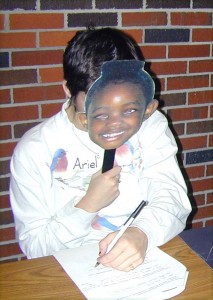 Activities: Small groups make decisions about (masked) people based on their age; discuss the validity of making those decisions
Activities: Small groups make decisions about (masked) people based on their age; discuss the validity of making those decisions
7. Adversity Ad-Lib – Objectives:
To increase participants awareness of and sensitivity to various mental, physical, and emotional disabilities.
- To enhance participant’s sensitivity in their interactions with others with or without disabilities.
- To help participants understand the challenges and stigma facing disabled persons.
Activities: Participants role play parts of hearing impaired person communicating with a person with a speech disability. Participants discuss the nature of being “different,” left out, laughed at, shunned and individual choices for how each person decides to conduct his or her life.
communicating with a person with a speech disability. Participants discuss the nature of being “different,” left out, laughed at, shunned and individual choices for how each person decides to conduct his or her life.
8. Look-A-Like – Objectives:
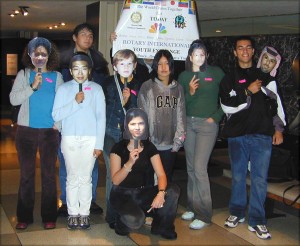 For participants to have the opportunity to compare objective and subjective assessments of themselves and others. For participants to understand issues involved in “Look-ism.”
For participants to have the opportunity to compare objective and subjective assessments of themselves and others. For participants to understand issues involved in “Look-ism.”
Activities:In pairs, participants make assessments of discuss answers.
9. Comfort Zones – Objectives:
For participants to discover and examine their own social comfort zones.
- To develop confidence and skills in expanding their comfort zones.
- To empower participants to help others to increase their own social comfort.
Activities: With masks and pop-up crowds, participants compare and discuss their social comfort levels.
10. Labels – Objectives:
To heighten participants awareness of the tendency to label people based on surface appearances.
- To help participants examine the labels they use to identify people.
- To help participants become more sensitive to language usage by understanding the impact and deeper associations of the words they use.

Activities: In pairs, participants “label” each other’s pop-up crowd with 5-6 words or phrases, then do word association exercise with original list. Discuss final label list concerning the nature of labels.
11. Roles & Games – Objectives:
To help participants understand inter-personal dynamics in “game playing.”
- To understand how and why individuals get locked into roles and behaviors in their interactions.
- To learn effective communication techniques they can apply in their personal lives and in the workplace.
Activities: In groups of three, each participant respectively takes on the role of victim, oppressor, or protector. Participants learn the nature of “game playing” in human interactions and how “not to play game” by “open, honest, direct, and appropriate communication. Participants discuss how they can apply this understanding in their lives and relationships. The nature of anger as a secondary emotion that acts to disguise a primary emotion is discussed.
12. Class Act – Objectives:
 For participants to examine attitudes concerning class and socio-economic realities of different populations. For participants to understand and ramifications of attitudes concerning “class” and socio-economic issues.
For participants to examine attitudes concerning class and socio-economic realities of different populations. For participants to understand and ramifications of attitudes concerning “class” and socio-economic issues.
Activities: Participants will participate in an exercise that replicates various class divisions, privileges and disadvantages. They will discuss their feelings and reactions towards the exercise.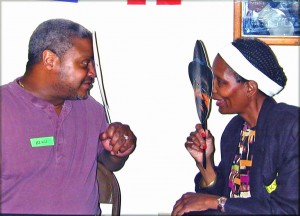
13. Issues of Access
Objectives: To review previous workshops
- To be introduced to the concept of “issues of access.”
- To feel empowered to look at their own behavior and thinking with a new view.
Activities: Review all exercises, discuss meaning of “issues of access” and being a light in a foggy world.
